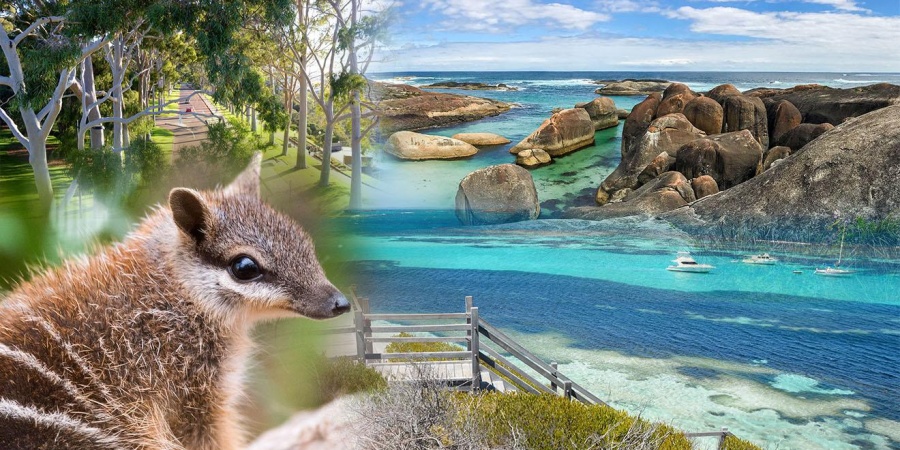
DBCA brings together the Parks and Wildlife Service, Botanic Gardens and Parks Authority, Zoological Parks Authority (Perth Zoo), Rottnest Island Authority, Conservation and Parks Commission, Swan River Trust (Swan Canning Riverpark) and Biodiversity and Conservation Science.
We work with the community to ensure that Western Australia’s environment is valued, protected and conserved, for its intrinsic value, and for the appreciation and benefit of present and future generations.
Our Mission, Values and Vision
Our mission
- Manage Western Australia’s parks, forests and reserves to conserve wildlife, provide sustainable recreation and tourism opportunities, protect communities and assets from bushfire and achieve other land, forest and wildlife management objectives.
- Inspire and act for wildlife conservation.
- Conserve and enhance Kings Park and Botanic Garden and Bold Park with the community, and to conserve biological diversity generally.
- Grow visitor numbers and yield by providing best-in-class tourism products, experiences and service while enhancing Rottnest Island’s unique heritage and environment.
- Provide scientific excellence and deliver effective conservation of Western Australia’s biodiversity.
Our values
Our values describe our commitment to our visitors, colleagues, partners, volunteers and supporters. They are:
- Integrity, a commitment to knowing and doing what is right.
- Collaboration, a commitment to team, partnership and the support of others.
- Accountability, a commitment to being transparent, taking ownership and personal responsibility.
- Respect, a commitment to the respect of people, culture and place.
- Excellence, a commitment to quality, innovation and continuous improvement.
We observe the highest standards of integrity at all times and expect those doing business with us to do the same to help us deliver public value. We act in accordance with our corporate values, the Public Sector Code of Ethics and comply with any legislation, policies and procedures set for the public sector.
Our vision for services delivered
Biodiversity and Conservation Science - Best practice biodiversity science and knowledge partnerships underpin conservation of Western Australia’s plants, animals, communities and ecosystems, and management of our lands and waters.
Botanic Gardens and Parks - To create and provide world recognised botanic gardens and parks and to inspire the conservation of biological diversity.
Parks and Wildlife Service - The natural assets of Western Australia are conserved, protected and valued.
Perth Zoo - A world where diversity of species and habitats is secure.
Rottnest Island - Rottnest Island is an internationally recognised, sustainable, must-visit tourism destination.
What we do
We work to conserve WA’s biodiversity, cultural and natural values. We also provide world-recognised nature-based tourism and recreation experiences for the community. We:
- manage WA’s parks, forests and reserves to achieve wildlife conservation
- provide sustainable recreation and tourism opportunities
- protect communities and assets from bushfire
- work to grow visitor numbers at Rottnest Island by providing best-in-class tourism experiences
- enhance Rottnest’s unique heritage and environment
- inspire and act for wildlife conservation at Perth Zoo
- work with the community to conserve and showcase our biological diversity at Kings Park and Botanic Garden and Bold Park
- provide support to the Conservation and Parks Commission and Swan River Trust
Scientific excellence underpins all we do. This ensures we deliver effective conservation of the State’s biodiversity.
Corporate documents
DBCA corporate documents, including annual reports, policies, legislation, freedom of information, administritive agreements, the department's Reconciliation Action Plan and Strategic Directions are available on the Governance and corporate documents page.
Streamline WA
DBCA manages over 31 million hectares of national parks, marine parks and other conservation reserves across the State supporting industries such as nature-based tourism, under the Conservation and Land Management Act 1984.
DBCA also manages biodiversity across the State and regulates its protection and use under the Biodiversity Conservation Act 2016.
In performing these management responsibilities, DBCA grants licences, permits and other authorities for a range of activities, uses and development.
In accordance with the WA Government’s response to the Independent Review of WA Environmental Approvals Processes and Procedures, legislative amendments have been made to the Environmental Protection Act 1986 (EP Act) to enable parallel decision-making for proposals that are subject to Part IV EP Act assessment. Proposals that are subject to such assessment may also require approvals from DBCA.
Further information regarding the recent parallel decision-making reforms can be found on the WA Government website, including the Parallel Decision-Making Policy. Under this policy, any applications seeking approval from DBCA can be parallel approved or parallel processed.
Parallel approvals
This new process enables DBCA to parallel approve applications while a proposal is subject to a Part IV assessment. This process is suitable if a proposal requires a secondary approval from DBCA. Relevant approvals include:
| # | Decision (Approval) | Legislative reference |
|---|---|---|
| 1 | Licence to take protected flora and fauna for biological assessment | r. 27 and r. 62 of the Biodiversity Conservation Regulations 2018 |
| 2 | Approval of a proposed management plan | s.8 and s.54 of the Conservation and Land Management Act 1984 |
| 3 | Approval for the grant of a lease or licence to authorise access to land or waters managed under the Conservation and Land Management Act 1984 – this will be determined on a case-by-case basis | Part VIII of Conservation and Land Management Act 1984 |
| 4 | Approval for tenure amendments to land or waters managed under the Conservation and Land Management Act 1984 – this will be determined on a case-by-case basis | s.9, 10A, 10, 17(6a) of the Conservation and Land Management Act 1984, s.45 and s. 46 of the Land Administration Act 1997 |
Parallel processing
In some instances, an approval in parallel cannot be issued, however improvements to assessment processes have been made for Part IV proposals that are not eligible for parallel approvals. Subject to a valid application and sufficient information being provided by proponents, DBCA can assess proposals in parallel with the Part IV EP Act assessment. DBCA can finalise decisions once the Minister for Environment’s decision under EP Act has been made. Relevant approvals include:
| # | Decision (Approval) | Legislative reference |
|---|---|---|
| 1 | Authorisation to take a threatened species or disturb a threatened ecological community | s.40 and s.45 of the Biodiversity Conservation Act 2016 |
| 2 | Approval of development in development control areas | s. 80(2)(c) of the Swan and Canning Rivers Management Act 2006 |
Preparing your application with DBCA
To streamline your assessment, we encourage you to provide detailed, quality information with your referral and applications as this can help reduce timeframes. Our Regulatory Documents page for licences and permits and authorisations provides information to assist you with preparing your application.
Preparing and submitting your proposal to DWER for EPA assessment (Part IV)
If you are submitting a proposal under Part IV of the EP Act for assessment, we encourage you to discuss your proposals with DWER, so they can work with you to scope your requirements, look at your assessment options, and provide guidance on processes and fees. Please refer to the EPA website and DWER’s One stop shop page for further information.
Frequently asked questions - Parallel decision-making
| Background | |
| Background |
|
| What is parallel decision-making? | The parallel decision-making reforms enable DMAs to make decisions in parallel to an environmental assessment process undertaken by the Environmental Protection Authority (EPA) under Part IV of the EP Act (a part IV assessment). This means that decisions can be made where appropriate – meaning proposals can be processed or approved in parallel. It is important to note that the prohibition on implementing a proposal before the Part IV assessment process is complete remains in place. |
| What has changed? | These reforms amended section 41 of the EP Act to allow other Government regulators to process and issue their own approvals in relation to a proposal while a Part IV assessment is underway. |
| Why have the parallel decision-making reforms been introduced? | To respond to the Independent Review of WA Environmental Approvals Processes and Procedures, which is aligned to WA Government’s objectives to maintain Western Australia’s rich biodiversity and natural environments. The review outlined there are several areas for improvement in areas where there is duplication, lacking coordination, culture, resourcing, and communications in Western Australia’s environmental regime. |
| Implementation of proposals | |
| Can proponents implement a proposal before the Part IV assessment is complete? | No – To ensure robust protections for the environment are maintained, the reforms make clear that no decision made in parallel to a Part IV assessment will have the effect of authorising a proposal to be implemented. Proponents will also still be legally prevented from implementing a proposal under s.41A of the EP Act. |
| What are the penalties for non-compliance? | New penalties apply to reflect the seriousness of implementing a proposal before a Part IV assessment process is finalised. Penalties have doubled as follows:
|
| Benefits | |
| When can proponents expect to start having their approvals decided in parallel? | The parallel decision-making provisions are now in effect. The decision timeframe on secondary approvals will depend on the specifics of each application, the requirements of the relevant decision-making authority, and any timeframes set by other legislative frameworks. Agencies are expected to begin parallel processing and approving applications, where appropriate and in accordance with the Parallel Decision-Making Policy. |
| What are the benefits of the parallel decision-making reforms? |
|
| Where can I find more information? | The Parallel Decision-Making Policy, published on the WA Government Streamline WA website, details how parallel decision-making is to be implemented across government. |










